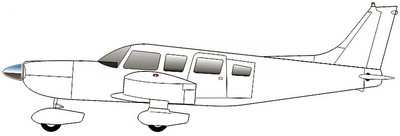Thu, Dec 07, 2023
Observed The Accident Airplane Flying South, Before It Began A Left Circling Turn With A “White Mist” Trailing The Airplane
Location: Marion, OH Accident Number: ERA24FA026
Date & Time: October 31, 2023, 11:23 Local Registration: N44601
Aircraft: Piper PA-32-300 Injuries: 2 Fatal
Flight Conducted Under: Part 91: General aviation - Personal

On October 31, 2023, at 1123 eastern daylight time, a Piper PA32-300, N44601, was destroyed when it was involved in an accident near Marion, Ohio. The pilot and pilot-rated passenger were fatally injured. The airplane was operated as a Title 14 Code of Federal Regulations Part 91 personal flight.
A witness stated that he was standing outside his house when he heard an airplane flying in the distance and the engine sounded like it was “oscillating.’ He looked up and observed the accident airplane flying south, before it began a left circling turn with a “white mist” trailing the airplane. He further stated that the engine “cut out” and the airplane went “nose down” and impacted the ground.
A residential video doorbell recorded the sound of the airplane prior to the accident. The engine sound was constant and consistent with a high rpm setting.
The wreckage was located in an open field, about a 1/2 mile from a county road. The airplane impacted the ground in a steep nose down, nearly vertical attitude. The magnetic heading was 090°. The engine and propeller were buried about 2 feet in the ground. A postimpact fire destroyed most of the airframe. The left wing displayed accordion crushing along the entire leading edge. Flight control continuity was observed to all primary flight controls through frayed cables and fractured bell cranks.

The propeller hub was fragmented and separated from the engine flange. The engine intake and exhaust pipes were crushed and separated. The Nos. 2, 3 and 4 cylinders were impact damaged. The No. 1 cylinder head and valves were impact damaged. The No. 2 cylinder head was separated from the barrel and impact fragmented. The barrel remained attached to the engine crankcase. The No. 3 cylinder head and valves were impact damaged. The No. 4 cylinder, connecting rod and piston were separated from the crankcase. A portion of the cylinder barrel flange and barrel remained attached to the crankcase. One connecting rod bolt was separated from the connecting rod and not observed. The rod was impact damaged. The No. 4 crankshaft rod journal was undamaged. No thermal discoloration or scoring of the journal surface was observed. The engine crankshaft could not be rotated by turning the propeller flange. The interiors of the cylinders, which remained attached to the engine were observed using a lighted borescope and
no anomalies were noted. Oil was observed in the engine. The oil suction screen contained ferrous metallic debris that was forwarded to the National Transportation Safety Board Materials Laboratory for further examination.
The wreckage was retained for further examination.
More News
From 2014 (YouTube Version): One Of The Airshow World's Pre-Eminent Formation Teams Chats About The State Of The Industry At EAA AirVenture 2014, ANN News Editor Tom Patton gets th>[...]
Tactical Air Navigation (TACAN) An ultra-high frequency electronic rho-theta air navigation aid which provides suitably equipped aircraft a continuous indication of bearing and dis>[...]
Aero Linx: Doobert Hi, we're Chris & Rachael Roy, founders and owners of Doobert. Chris is a technology guy in his “day” job and used his experience to create Doobe>[...]
The Airplane Was Spinning In A Nose-Down Attitude Before It Impacted Terrain On June 20, 2025, at 0900 eastern daylight time, a Pitts Aerobatics S-2B, N79AV, was destroyed when it >[...]
Also: United Elite Sues, Newark ATC Transitions, Discovery Moves?, Textron @ KOSH The Commemorative Air Force Airbase Arizona is taking its “Flying Legends of Victory Tour&rd>[...]
 Classic Aero-TV: Up Close And Personal - The Aeroshell Aerobatic Team at Oshkosh
Classic Aero-TV: Up Close And Personal - The Aeroshell Aerobatic Team at Oshkosh ANN's Daily Aero-Term (07.13.25): Tactical Air Navigation (TACAN)
ANN's Daily Aero-Term (07.13.25): Tactical Air Navigation (TACAN) ANN's Daily Aero-Linx (07.13.25)
ANN's Daily Aero-Linx (07.13.25) NTSB Prelim: Pitts S2
NTSB Prelim: Pitts S2 Airborne 07.09.25: B-17 Sentimental Journey, Airport Scandal, NORAD Intercepts
Airborne 07.09.25: B-17 Sentimental Journey, Airport Scandal, NORAD Intercepts




